Top News
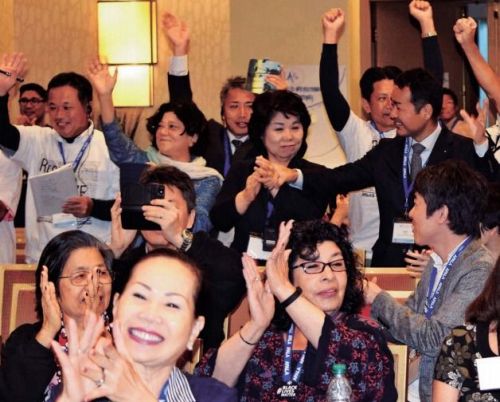
August 21, 2017 Ryukyu Shimpo
Special Correspondent Yukiyo Zaha reporting
On August 19 the Asian Pacific American Labor Alliance (APALA) held the general session of its 25th Anniversary Convention in Anaheim, California. There, APALA adopted a resolution opposing the plans for new base construction in Henoko, Nago City, and Takae, Higashi Village in Okinawa.
This is the second time that APALA has adopted a resolution claiming solidarity with Okinawans, the first time being in 2015. APALA is an influential labor organization with more than 20 chapters throughout the U.S. and 660,000 members.
The second delegation of the All-Okinawa Council to the U.S. for APALA’s general meeting, the objective of which is to not allow construction of the new base in Henoko, held a workshop concerning the Okinawa base problem.
Led by House of Councillors member Yoichi Iha, the delegation presented information to APALA members about the current status of U.S. military bases in Okinawa, the citizens’ protest activities in Henoko and Takae, and issues of sexual violence.
Titled “Solidarity with the People of Okinawa,” the APALA resolution declares opposition to the expansion of U.S. military bases in Okinawa, including the base constructions plans for Henoko and Takae.
It also requests that each labor union, central labor council, and state government pass a similar resolution. Furthermore, the resolution calls on the U.S. Congress “to withhold support for the U.S. military expansion on Okinawa and to respect the democratic wishes of the people of Okinawa.”
Former president of APALA and the UCLA Labor Center Director Kent Wong proposed the resolution at the request of the All-Okinawa Council.
Head of the All-Okinawa delegation Iha said, “We will not allow new U.S. military bases to be built in Okinawa,” and suggested that the U.S. and Japanese governments should solve Okinawa’s U.S. military base problem.
His statement was met with a burst of applause from the 600 or so people gathered in the assembly hall.
At the convention’s dinner program the All-Okinawa delegation members sang the traditional Okinawan songs Bashofu and Tinsagu nu Hana.
The assembly hall grew enlivened through Okinawan kachashi dancing, which promoted a sense of friendship between the All-Okinawa delegation and APALA members.
(English translation by T&CT and Erin Jones)
Go to Japanese
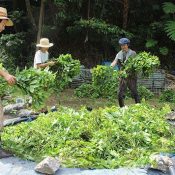
August 17, 2017 Ryukyu Shimpo
By Hiroshi Uema
Motobu – Ryukyu-ai (Ryukyu indigo) is a plant that has been cultivated in Okinawa as the base material for unbeatable indigo dyes since ancient times.
The Higa Ryukyu-ai Factory (Yoshimatsu Higa, President) produced Ryukyu-ai indigo balls using traditional indigo pots from June 22 through July 16 in Yamazato, Motobu.
The three people producing the traditional Ryukyu indigo were President Higa (Motobu), Takashi Sawano (Ogimi), and Nozomi Sato (Ogimi. The process involved submerging around 400 kg. of indigo leaves into a single cistern, which was done six times.
The result was a total of around 2,600 kg. of indigo leaves’ worth of indigo dye balls.
The facilities are deep in the nature-rich mountains, and have been in operation for three generations, from Higa’s grandfather Yoshitaka, his father Yoshiari, and Higa himself.
The indigo plants were planted and raised starting in November of last year.
Indigo making requires a large volume of water, and the facility makes use of a nearby spring.
Higa commented, “I want to continue to plant and grow Ryukyu-ai every year, and continue making dye.”
(English translation by T&CT and Sam Grieb)
Go to Japanese
August 23, 2017 Ryukyu Shimpo
On August 21 (local time), the 9th Circuit U.S. Court of Appeals dismissed the lower court’s decision in the Okinawa dugong lawsuit in which Okinawan community members and American and Japanese conservation groups filed a lawsuit against the U.S. Department of Defense. The groups have been seeking to block construction of a new U.S. military base in Henoko, Nago, on the grounds that it will damage the habitat of the Okinawa dugong, an endangered marine mammal designated by the Japanese government as a natural monument. The U.S. District Court in San Francisco dismissed the suit in 2015 because it was not authorized to order the suspension of construction work.
The U.S. Federal Appeals Court’s ruling partly affirmed the plaintiffs’ argument that seeking suspension of the construction of the new base in Henoko is not a political issue. The lawsuit will enter into substantive examination, including whether to cancel the construction of the new base.
Local citizens who are opposed to the new base’s construction welcomed the ruling, saying, “the road has opened.”
In 2003, the Okinawan community members and the conservation groups, including the Japan Environmental Lawyers Federation (JELF) and the Center for Biological Diversity, filed a lawsuit seeking an injunction against the construction of the new base, arguing that the Department of Defense has an obligation to protect the dugongs based on the National Historic Preservation Act (NHPA).
However, the district court dismissed the plaintiffs’ suit on the basis that it had no legal authority to order suspension of the construction work, which the Japanese and the U.S. governments have been conducting based on a diplomatic agreement. The plaintiffs were dissatisfied with the ruling and appealed in April 2015.
Following the federal appeals court ruling, the Department of Defense has to negotiate with stakeholders including the Okinawa Prefectural Government, local residents, and environmental protection groups. The ruling asks the government to provide effective conservation measures for dugongs.
As of now, the Department of Defense has not given a view on the ruling.
The plaintiffs asserted in a statement that dugongs cannot survive under the current base construction plan, and praised the appeals court ruling saying that it would be a lifeline for the dugongs.
Takaaki Kagohashi, former president of the JELF, said, “The U.S. judiciary has confirmed it will strictly watch the administration’s power.”
Kagohashi spoke of his expectations, saying, “The way has opened towards suspension of the construction.”
Kagohashi pointed out the possibility of the U.S. government to appealing to the Supreme Court, and he said, “We will prepare our strategy to block the base construction with the support and understanding of the Okinawan people and U.S. citizens.”
(English translation by T&CT)
Go to Japanese
August 20, 2017 Ryukyu Shimpo
It may be obvious, but the relationship between Japan and the U.S. is not equal; the imbalanced power relationship continues.
This once again became clear at the joint presentation and press conference for the “2-plus-2” ministerial security talks held in Washington between Japan’s Foreign and Defense Ministers and the U.S.’s Secretaries of State and Defense.
Japan brought up the issues of the continued use of the former aircraft parking apron at Kadena Air Base, and the parachute training problem.
On August 14, Governor Takeshi Onaga strongly implored Defense Minister Itsunori Onodera to discuss the issue at the 2-plus-2 talks.
Both the continued use of the aircraft parking apron and parachute training issues are in violation of the agreement reached in the 1996 Special Action Committee on Okinawa (SACO).
In order to reduce noise pollution, it was agreed that the parking apron be moved to the opposite side of the airstrip near Okinawa City, and the relocation happened in January of this year.
However, the U.S. military continues to use the decommissioned apron. This is a clear violation of the agreement.
It was also agreed that parachute training would take place between Yomitan Auxilliary Airfield and Ie Shima Airfield.
In 2007, Japan and the U.S. agreed that “Kadena Air Base could be used in exceptional cases,” however in May of this year, when night jump training was conducted at Kadena, then Defense Minister Tomomi Inada commented that, “This could not be considered an ‘exceptional case’,” and indicated that it was a violation of the agreement.
Both of these issues are matters which Japan needed to press the U.S. on with authority at 2-plus-2 so that they immediately cease these violations of the agreement, even without the urging of Governor Onaga.
How did Defense Minister Onodera and Foreign Minister Taro Kono make these requests to the U.S. at 2-plus-2? Based on the explanation given during interviews, there is no evidence to suggest they made a strong appeal.
Defense Minister Onodera said, “We explained the local community’s strong requests, and again requested consideration and security for the area around the base.
” Foreign Minister Kono added, “We indicated the need for understanding and cooperation with the local community.”
Neither of the two ministers gave any indication that they represented the Japanese government’s position with regards to the failure to uphold the international agreement.
The only thing requested of the U.S. was for “consideration” and “understanding and cooperation” for the “local community” of Okinawa’s “strong requests.
” In other words, they are speaking as if it were someone else’s problem.
Unsurprisingly, the U.S. gave no clear response to the use of the parking apron or the cessation of parachute training.
Why would they? The appeal was nothing more than an excuse claim they gave the Governor’s demand, with no expectation of an answer from the U.S. We have no choice but to be fed up with Japan’s continued lapdog attitude.
With regards to the MCAS Futenma relocation they confirmed that new base construction at Henoko in Nago City would continue, stating, “Henoko is the only solution to prevent Futenma becoming permanent.
” On August 12, 45,000 people gathered in Naha for a demonstration to demand the stoppage of new base construction.
The Japanese federal government did not lend a single ear to the fervent opposition voices in Okinawa, submitting to America’s will and forcing construction ahead.
How long will Japan’s subservient relationship with the U.S. continue? Okinawa cannot continue to tolerate being the victim of this twisted relationship.
(English translation by T&CT and Sam Grieb)
Go to Japanese
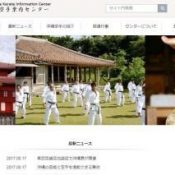
August 20 2017 Ryukyu Shimpo
The Okinawa Karate Information Center has started a website in multiple languages.
The center was set up in the Okinawa Karate Hall in Tomigusuku City to make it known both at home and abroad that Okinawa is the birthplace of Karate, and to facilitate hosting karate enthusiasts.
In addition to promoting Okinawan Karate and responding to inquiries, the center will coordinate arrangements for both domestic and foreign karate practitioners to train at dojos (training halls) around the prefecture.
The center was set up by the Okinawa Traditional Karatedo Promotion Association and commissioned by the Okinawa Prefectural Government.
The prefectural government is planning to promote karate as a new tourism drawcard. The center will become one of the core promoters of karate to domestic and foreign people.
In late July, the center set up a website in multiple languages.
Inquiries can be made by telephone, email and the website.
The website is currently available in Japanese and English, and in the near future French and Spanish versions will be added.
According to the prefectural government, the center received nearly 20 requests from karate lovers in many countries such as India, Austria, Brazil, Spain and others, between May and June.
The center introduced them to local dojos.
(English translation by T&CT)
The Okinawa Karate Information Center’s website is http://okic.okinawa/
Go to Japanese
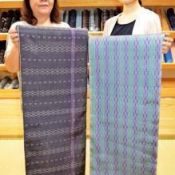
August 14, 2017 Ryukyu Shimpo
The 37th Pola Traditional Culture Award has chosen prize winners among individuals and groups contributing to the succession and promotion of traditional culture.
The Ryukyu Kasuri Business Cooperative, which has contributed to the preservation and succession of Haebaru Hanaui, won the regional award for Okinawa Prefecture.
An award presentation ceremony will be held in Tokyo on October 24.
Director Shiroma said, “Haebaru Hanaui was designated a traditional craft, and people in the community have reaffirmed the beauty of Haebaru Hanaui.
That led to winning the award. We would like to work as a community to pass down precious cultural heritage.”
The Ryukyu Kasuri Business Cooperative was established in 1975. In order to halt the decline in the number of active producers, the Cooperative started successor training for Ryukyu Kasuri and Haebaru Hanaui in 1981.
In January, in response to the designation of Haebaru Hanaui as a traditional craft by the state, the Cooperative set out to begin successor training specializing in Haebaru Hanaui. The training started in August.
This year, two nominations from the whole country were selected for the Excellence Award, one for the Encouragement Award, and five for the Regional Awards.
(English translation by T&CT and Megumi Chibana)
Go to Japanese
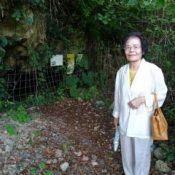
August 16, 2017 Ryukyu Shimpo
June 24 saw the release of the film “Hacksaw Ridge,” which takes place at the Maeda escarpment in Urasoe, Okinawa, which was the site of ferocious fighting during the Battle of Okinawa.
Since the film’s release, tourists have flocked to weekend tours of the area, indicating a high level of interest.
These tours are conducted by the municipal tourism association.
However, no civilians appear in the film, which features U.S. military combat medic Desmond Doss as its protagonist and includes many battle scenes.
Ms. Hatsue Hanashiro, 85, of Urasoe survived the battle by taking refuge in a cave near the Maeda escarpment.
“I want people to know that in the battle of Okinawa, not only were countless lives of unarmed civilians lost; those who survived were also robbed of their hopes and dreams,” says Hanashiro.
At the end of March 1945, when U.S. naval gunfire and aerial bombing grew fierce in what was then Urasoe Village, Hanashiro and seven of her family members took shelter in the “Kuchigwa cave” within the grounds of Urasoe Castle, where the Maeda escarpment is located.
The family members with her were her grandmother, then 68, her mother, then 41, her younger sister, then 7, her younger brother, then 3, and three other relatives.
They had also considered escaping to the southern part of the island, but decided it would be too hard for her elderly grandmother and young brother to walk such a long distance, and instead took refuge in the Kuchigwa cave near their home.
The film “Hacksaw Ridge” depicts a ferocious shoot-out between U.S. and Japanese forces, and Hanashiro says that Japanese soldiers would emerge from among large trees near the Kuchigwa cave to fire cannons at their adversary.
She says that sometimes she would leave the cave to gather water, but adds, “I was targeted by machine-gun fire. I would lie on the ground pretending to be dead and wait for the U.S. aircraft to leave.”
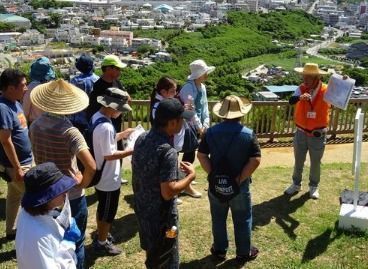
A tour of the Maeda escarpment introducing “Hacksaw Ridge” and other features at the end of July in Urasoe, Okinawa
When the U.S. military shot shells near the cave, they emitted explosive noise and the ground shook.
The blast wave blew all the way into the cave, and Hanashiro says that when she looked up, pieces of human flesh were adhered to the ceiling of the cave.
“I didn’t know if it was from the body of a nearby Japanese soldier or a civilian, but I thought that hell must be what I was experiencing then,” says Hanashiro.
Hanashiro and her family had to live for an extended period of time without food or water. On May 5, 1945, she fled the cave and headed toward the well at her home, thinking that if she was going to die anyway, she at least wanted to drink her fill of water first.
When she left the cave, “there were blackened, swollen corpses everywhere,” she says. These must have been the bodies of the Japanese soldiers killed in the battle at the Maeda escarpment depicted in the film.
Hanashiro heard about the film “Hacksaw Ridge” from her daughter.
“I have no interest in seeing it. I don’t want to remember,” she says reticently.
Then, with strength, she says, “We must never make war again.”
(English translation by T&CT and Sandi Aritza)
Go to Japanese
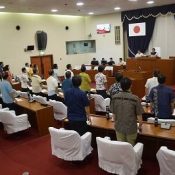
August 18, 2017 Ryukyu Shimpo online edition
On August 18 at an extraordinary session of the Ginowan City Council, the council unanimously voted to adopt a protest resolution and written argument demanding a speedy investigation and announcement regarding the cause of the recent crash off the coast of Australia of an MV-22 Osprey vertical takeoff and landing aircraft from Futenma Air Station.
The resolution and argument also demanded a suspension of Osprey flights, the prompt closure and return of Futenma Air Station, and implementation of the five-year-period closure of the base.
The resolution and argument refers to the Osprey crash in December last year as well as the two emergency landings in June this year, pointing out that Osprey keep causing trouble.
The documents mention that local citizens are dragged into serious accidents connected to these aircraft, spreading shock, anxiety, and dread among Okinawans.
In addition, the resolution and argument call for a drastic revision of the U.S.-Japan Status of Forces Agreement (SOFA).
Chairman Masatoshi Oshiro of the Ginowan City Council and members of the U.S. military base special committee delivered the protest resolution and argument directly to the Marines in Okinawa, the U.S. Consul-General in Okinawa, the Ministry of Foreign Affairs’ Okinawa Liaison Office, and the Okinawa Defense Bureau.
(English translation by T&CT and Erin Jones)
Go to Japanese
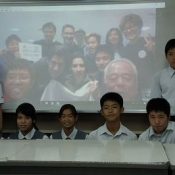
August 17, 2017 Ryukyu Shimpo Digital Edition
On August 17, 10 students who take part in international exchange for their integrated studies course at Konan Junior High School interacted with an Okinawan Prefecture Association in Argentina via Skype, an Internet-based video teleconferencing application.
Besides performing the Sanshin and the Eisa, the students also asked questions about life in Argentina.
The students used Skype for about an hour from 8 a.m. (8 p.m. on August 16 in Argentina).
The Skype session concluded with both parties singing “Shimanchunu takara.”
In response to ninth-grader Miaki Teruya’s question, “What do you think about Okinawa?” the Chairman of the Okinawan Prefecture Association in Argentina, Akira Tamaki responded with a smile and said, “To us, Okinawa is amor (love) and familia (family).
” The students listened with enthusiasm.
A teacher from Konan Junior High School, Yoshino Higa said, “The students superficially learn about foreign countries via textbooks.
By actually speaking with people who live there, they learn for the first time exactly what people there think about.
We want them to appreciate the connection with Okinawan people living abroad.”
Ninth-grader Hikaru Itosu said, “I was nervous, but had fun. It would be great if the interactions between the world and Japan continue to deepen.”
(English translation by T&CT and Chelsea Ashimine)
Go to Japanese
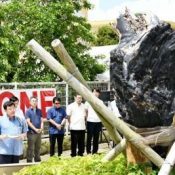
August 14, 2017 Ryukyu Shimpo
August 13 marked thirteen years since the U.S. military helicopter crash on Okinawa International University’s campus in Ginowan City.
The university held a gathering to demand the closure of Futenma Air Station and to transmit the value of peace.
President of the university Eiken Maetsu made a request to the U.S. and Japanese governments for the closure and removal of Futenma Air Station.
The Osprey from Futenma cause crashes one after another, in turn raising Okinawans’ apprehension of U.S. aircraft accidents.
Maetsu said of the successive crashes: “I am reminded of the tragedy thirteen years ago.
With aircraft flying overhead in Okinawa the danger will only grow.”
“Won’t there just be another crash?” was one of the concerns voiced by the attending Ginowan City residents, burdened by Futenma Air Station.
The gathering started at 2:00 p.m., close to the time that the accident occurred in 2004, and around 140 people attended, including university students and staff.
Recent examples of Osprey from Futenma Air Station crashing are the accident in the shallows in Abu, Nago City in December last year, and the accident off the east coast of Australia earlier this month.
Maetsu said: “Even with the exception [of Osprey] other aircraft frequently cause accidents. It is common knowledge that the root of the danger is the presence of the U.S. military bases.”
Okinawa International University senior year student, 22-year-old Minoru Oshiro, said, “The helicopter accident instilled residents in the surrounding areas with dread and anger.
We should not dismiss it as a thing of the past.” He added, “As one of those who are responsible for the future of Okinawa, I would like to make it known that the people of Ginowan live in an unpalatable situation.”
(English translation by T&CT and Erin Jones)
Go to Japanese
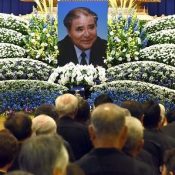
August 10, 2017 Ryukyu Shimpo Digital Edition
(Okinawa) On the afternoon of August 10, a funeral for former Okinawa Development Bureau director Kosuke Uehara, who died at 84, was held at the Sunray Central Okinawa Shiunkaku in Okinawa City.
Uehara’s friends and associates from his time in the Okinawa Garrison Forces Labor Union (Zengunro, now Zenchuro) and members of the political world attended the funeral to pay their last respects.
Shinsuke Tomoyose, who participated with Uehara in the Zengunro struggle, gave a eulogy, saying, “The sorrowful time has finally come to say our last goodbye.
[Uehara] played a decisive role in an era of great turbulence. [His life] embodied Okinawa’s postwar history.”
Influenced by his experience during the Battle of Okinawa, Uehara participated in the struggle for improved treatment of Okinawan laborers working on U.S. military bases as chair of the Okinawa Garrison Forces Labor Union, and also participated in the anti-war peace movement.
He served ten terms as a representative of Okinawa in the House of Representatives in the national Diet, and was the first Okinawan Diet member to serve as a Cabinet minister. He endeavored to address and resolve issues of Okinawa’s development and revitalization, U.S. base issues, and postwar recovery.
(English translation by T&CT and Sandi Aritza)
Go to Japanese










 Webcam(Kokusai Street)
Webcam(Kokusai Street)


